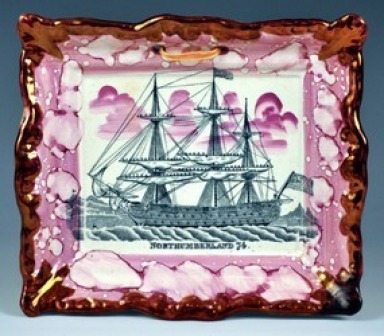|
8/4/2010 0 Comments Dixon datesA website is a great way to visually arrange your thoughts. When I set out plaques with known dates in chronological order (see Plaque dates subpage), one of them stuck out like a sore thumb. 'Northumberland 74' plaques come with two impressed marks: – 'Dixon, Phillips & Co' surrounding an anchor (top plaque below) – 'Dixon Co' (bottom plaque below) Baker (page 64, 1984 edition) suggests a date span of c1815–20 for the former. Napoleon was transported to Saint Helena on HMS Northumberland in 1815, which presumably is the reason for this date. My instinct is that a date of even 1820 might be too early for this plaque. In terms of the development of plaque shapes and forms, it sits much more comfortably in the 1830s or 40s. Baker gives the probable ownership of the Dixon and partners pottery as follows:
1807 to 1812, John Phillips 1813 to 1819, Phillips & Co and/or Dixon & Co 1820 to 1826, Dixon, Austin & Co 1827 to c1834–39, Dixon, Austin, Phillips & Co c1834–39 to 1865, Dixon, Phillips & Co My hypothesis is that the Dixon, Phillips & Co anchor mark was first used c1834. The anchor impressed mark is found on plaques titled 'Ancient Order of Foresters', founded in that year. The Dixon, Phillips & Co anchor mark was used up to c1850, when it appears on Peel commemorative plaques. Soon after it was replaced by the 'Dixon Co' impressed mark. NB there is no ampersand (&) in this later impressed mark. For a year or so I've kept a spreadsheet of which Dixon marks appear on which plaques. As with Northumberland 74, both marks regularly appear on religious verse plaques, and rectangular plaques with Wesley and Clarke. 1851 is the earliest date I've suggested for a plaque stamped 'Dixon Co'. (The Long Family History plaque, with the last death recorded 1851. NB, the plaque might have been commissioned a year or two later.) The Dixon Co mark appears on items made after 1851, eg Crimean war plaques (c1853) and Garibaldi (1854). I've never seen those items with the earlier anchor mark. Likewise, I've never seen a Foresters (c1834) or Peel plaque (c1850) with the Dixon Co mark. When circular pink-lustre plaques are marked, they always seem to have the Dixon Co mark, and never the anchor. So presumably that plaque form post-dates 1850. There is the possibility that the two marks were used during overlapping periods, but I've found no evidence of that yet. Another reason I think the c1815–20 date for Northumberland 74 is unlikely, is that the later Dixon Co versions have reasonable transfer definition. If the copper plate was used over a 50-year period, we'd expect more signs of wear. In fact, there's little discernable difference between some earlier and later marked plaques. Anyway, would it have been commercially viable for Dixon to sell the same plaque for 5 decades? One thing the Plaque dates page demonstrates is the pressure for innovation and novel forms of plaque. One final question though... Why would Dixon have chosen to commemorate a ship long after its active service? Perhaps because the subject had resonance for local people (Sunderland being in the county of Northumberland). As always, I'd be glad to hear from anyone with marked wares that defy my speculations!
0 Comments
Leave a Reply. |
AuthorStephen Smith lives in London, and is always happy to hear from other collectors. If you have an interesting collection of plaques, and are based in the UK, he will photograph them for you. Free advice given regarding selling and dispersal of a collection, or to those wishing to start one. Just get in touch... Archives
February 2022
AcknowledgementsThis website is indebted to collectors, dealers and enthusiasts who have shared their knowledge or photos. In particular: Ian Holmes, Stephen Duckworth, Dick Henrywood, Norman Lowe, Keith Lovell, Donald H Ryan, Harold Crowder, Jack and Joyce Cockerill, Myrna Schkolne, Elinor Penna, Ian Sharp, Shauna Gregg at the Sunderland Museum, Keith Bell, Martyn Edgell, and Liz Denton.
|

